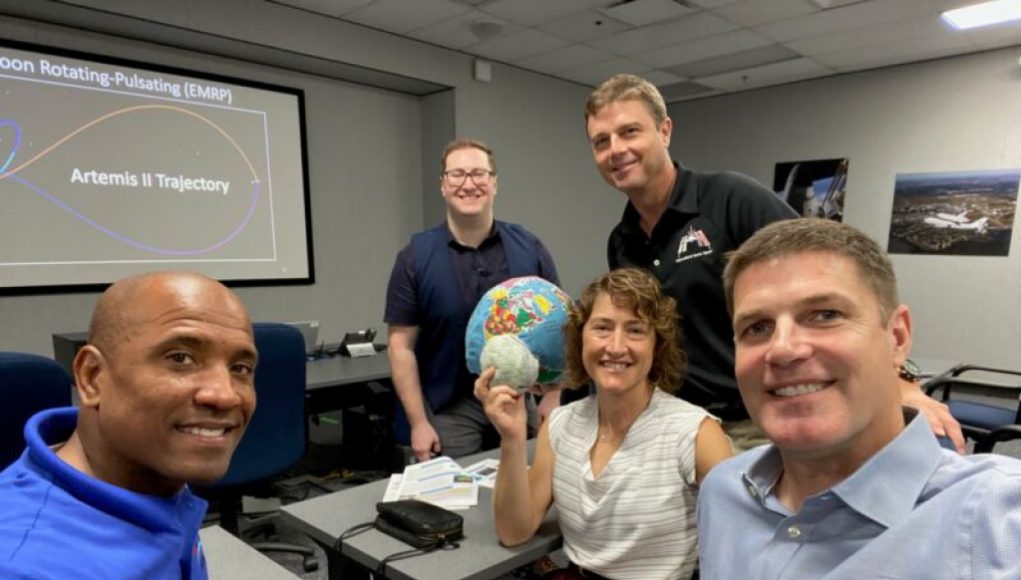Prepare for an epic journey beyond the far side of the Moon with NASA’s Artemis II mission! The four astronauts chosen for this historic mission recently gathered at the Johnson Space Center in Houston, where they embarked on an intensive training program. These brave individuals will be the first to fly around the Moon since 1972, and the anticipation is palpable.
But before they can embark on their lunar adventure, the crew must undergo rigorous training. Over the next 18 months, they will spend countless hours in classrooms, simulators, and airplanes, absorbing crucial knowledge and honing their skills. In the simulator, they will face challenging malfunctions and anomalies, testing their ability to overcome potential failures that could jeopardize the mission.
Jacki Mahaffey, NASA’s leading training officer for the Artemis II mission, emphasized the importance of hands-on experience. “The more we can immerse the crew in the vehicle mockups and the mission environment, the better prepared they will be,” she explained.
Commander Reid Wiseman, pilot Victor Glover, mission specialist Christina Koch, and Canadian astronaut Jeremy Hansen make up the Artemis II crew. Since their announcement, they have been busy with public appearances, interviews, and visits to NASA centers and government officials.
Advertisement
The crew also had the privilege of receiving a pep talk from Charlie Duke, who walked on the Moon during the Apollo 16 mission in 1972. Duke expressed his excitement for the Artemis II crew and their upcoming adventure.
Now, the crew has officially begun their training. Their first day included a preview of the syllabus and a lesson on lunar orbital mechanics. Throughout June and July, they will focus on mastering the fundamentals of the mission, familiarizing themselves with the Orion spacecraft and the Space Launch System rocket.
The Artemis II mission is expected to last around 10 days. It will begin with a launch from NASA’s Kennedy Space Center in Florida, followed by critical checkouts of the Orion capsule’s life support systems and a test of its ability to approach another object in space. This mission will pave the way for future Artemis missions, which will involve rendezvousing with a lunar landing craft in deep space.
NASA will be reinstating lunar flights for the first time in five decades, with an array of astronauts newly trained to make the journey.
NASA has been preparing to send the next generation of humans to explore the moon for some time. For the first time in over fifty years, the agency has qualified a group of astronauts to make the historic voyage. The selectees include current and former military personnel and experienced spacers, all of whom have undergone intense training to prepare them for the mission.
The astronauts have undergone a variety of training exercises in order to equip them for the mission. To simulate the characteristic delayed communication of deep-space crossings, a full-sized lunar module and simulator was utilized. The astronauts were also subject to gravitational alterations in order to acclimatize them to the zero-gravity environment of space travel. Additionally, they underwent simulation testing for landing and aborting a flight in order to prepare them to make quick decisions in a dynamic environment.
NASA has also expanded its initiatives for space flight safety. The agency has begun testing flight systems intended to minimize the risk of loss, leakage, and fire whilst in flight. Furthermore, NASA has designed smaller spacecraft for the journey in order to optimize fuel and maximize efficiency.
The agency is unable to provide an official launch date for the mission, though they are confident the training and safety protocols developed have prepared the astronauts ready to explore the moon.
This new mission testament marks a significant milestone in space exploration. After more than 50 years, humans are hurtling towards the stars once again in search of new frontiers. The generation of astronauts chosen for this historic voyage will surely be remembered in history books.




















![Namibian Fairy Circle Debate Intensifies: Sand Termites or Turing Mechanism? [Updated] Namibian Fairy Circle Debate Intensifies: Sand Termites or Turing Mechanism? [Updated]](http://neuralnation.net/wp-content/uploads/2023/07/2941-fairyTOP-800x529-100x75.jpg)